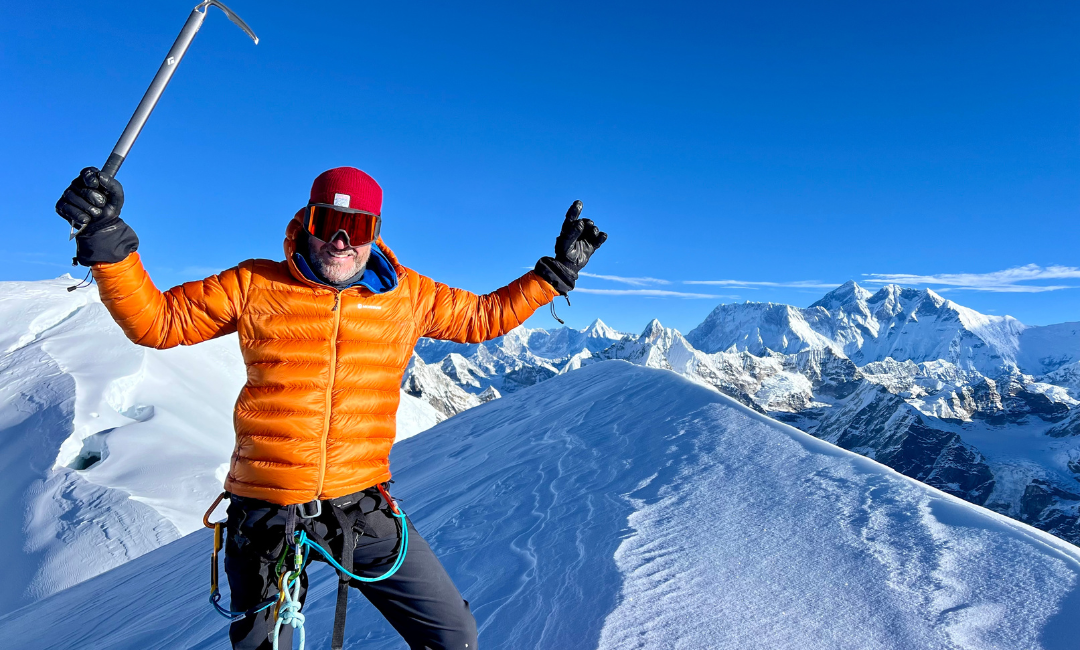
Preparing for Great Heights
On the 4th October 2024, seasoned adventurer, Jim Hart, summited Nepal’s Mera Peak (6,476m) despite facing the worst snow to hit the region in eight years.
Summitting these mountains takes years of planning and preparation. Jim has climbed Kilimanjaro, Kala Patthar and Mount Toubkal, and has plans to return to Nepal in 2027. As someone whose sights are always fixed on the horizon, Jim's drawn up some hints and tips for all those who - like him - are seeking to push their boundaries among the mountaintops in 2025.
-
Consider the logistics
All expeditions at altitude are as much a logistical challenge as they are a physical one. The first thing to consider is whether you feel comfortable planning the trip yourself, or would prefer to have an expert take care of the logistics.
Be aware that access to the mountain ranges in most countries requires authorisation and/or some form of local representation. You’ll either need to book local guides or use a UK expedition company to arrange this on your behalf.
In my experience, you get what you pay for. Some of the cheaper organisations don’t allow for medical expertise, which can mean there is no doctor around if you are hit with altitude sickness – and this can immediately put an end to your trip. If you decide to put aside more funds for experienced guides, it can mean the difference between summiting or not.
-
Don’t skimp on insurance
Irrespective of where you are going, don’t cut corners when it comes to insurance. Be honest when describing your adventure so the insurer understands the risks. If you choose to go with an expedition company, they should be able to provide this, but I've always found that Campbell Irvine has been a good option for me in the past.

-
Make a kit list
When you come to making a kit list, you’ll find you end up with an extensive list of essentials (plus a few ‘nice to haves’, which are really down to personal preference – mine always include a YETI flask and some Raw Bean Proper Coffee).
Your essentials should cover everything from base layers to keep you warm right through to technical equipment for mountain climbing (axes, harnesses, crampons etc.) Although technical gear can generally be rented at your destination, I prefer to take my own so I know it’s good quality and in good nick.
You’ll soon realise this isn’t a cheap hobby! It’s well worth scouring the internet for second-hand finds – Vinted, eBay and Facebook Marketplace often have good bargains. And if you look after your kit, it should serve you well.
-
Train hard
Train hard and train often to make sure you’re in optimal fitness. The fitter you are in the run-up to your trip, the easier the adventure is going to be, and the more you’ll get out of it.
We are lucky to have plenty of beautiful mountains to climb in the UK, and I get out as often as I can. I’d recommend doing the Three Peaks challenge by climbing Yr Wyddfa (previously named Mt Snowdon), Scafell Pike and Ben Nevis. Rather than trying to do them all in 24h, be clever about it and hike the three mountains over three days – when you’re at altitude, you make a slow ascent to make sure you acclimatise, and so this allows you to do something similar in your training.
If you’re heading for 6,500m and above, you could consider using an altitude facility, but be mindful of the expense.
There’s a lot of admin involved in expeditions of this nature, but there's so much to enjoy along the way. Climbing Mera Peak was without a doubt the biggest challenge of my life, but one hell of an adventure. Just don’t forget to look up – that’s where the best views are. Oh, and pack a Firepot or two so you’re eating as well as you possibly can.
Jim is heading for a third summit of Mount Toubkal this Christmas but has his sights firmly set on climbing Himlung Himal in 2027. Standing proudly at 7,000m, Himlung Himal is in northern Nepal, right beside the Tibetan border, and is a popular mountain for those training for 8,000m climbs. You can follow Jim’s adventures @jimhartuk.


